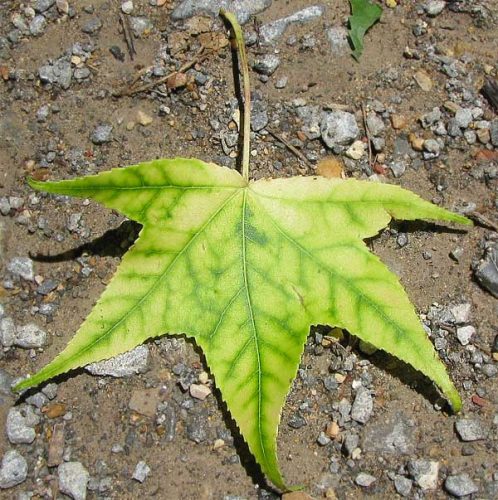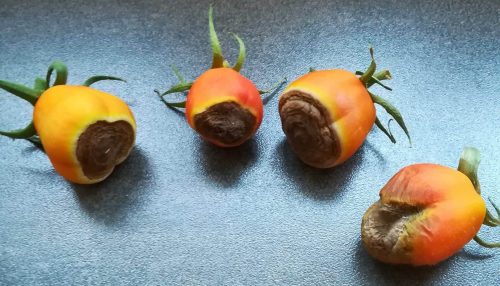Lettuce produces a lot of leaves and therefore needs a nutritious soil. Food shortage causes premature shooting.
Sprouts: if the leaves turn purple and the plant remains small, the plant is lacking food.
Tomatoes are sensitive to blossom end rot: brown spots appear on the underside of the tomato. Blossom end rot occurs because the mineral balance in the soil is out of balance. It occurs in warm weather, where the plant evaporates quite a bit of water, which lowers the calcium level in the plant to such an extent that the cell walls weaken and the cells start to leak. The brown spots are the result.
A discoloration of the leaf green between the veins to yellow-green is called Chlorosis , a sign of deficiency disease. Chlorosis is therefore a collective name for various deficiency diseases.
Trace elements
Trace elements are substances that occur in the soil and are absorbed by plants in very small quantities; some of them, such as boron (B), manganese (Mn), molybdenum (Mo), iron (Fe), zinc (Zn) and copper (Cu) are necessary for a plant. These metals fulfill many essential functions in the plant. Due to a shortage of trace elements in the soil, plants develop deficiency symptoms (discolored leaves, brown edges, limp).
An overview of the most important trace elements:
Boron – important for the roots. When there is a shortage of boron due to a pH that is too low or too high, the growing points of crops die. Heart rot in beets, maize and Brussels sprouts is an example of this. The mineral nitratine (also known as: Chile saltpetre) contains, among other things, boron.
Calcium – gives the plant its strength and regulates the pH. In case of deficiency, the leaf shrivels. An excess of calcium raises the pH in the soil, so that trace elements can no longer be properly absorbed by the plant. Blossom end rot is a result of calcium deficiency, as well as glassiness in apples . See also: calcium deficiency.
Chlorine – plants do not need chlorine, but it is absorbed by plants. Chlorine in the form of salt (sodium chloride) inhibits growth. Salty soil is harmful to crops, growth is stunted, plants lose their resistance to diseases and fungi, leaf size decreases – harvests are reduced. Potatoes and flower bulbs are sensitive to salt damage.
Copper – necessary for photosynthesis and the formation of chlorophyll. A high pH and over-fertilization lead to a copper deficiency; deformed leaves are the result.
Iron – necessary for nitrogen fixation and oxygen transport in the plant. A high pH of the soil, an excess of phosphates and lime cause a lack of iron, which causes yellowing of the leaves.
Magnesium – determines the chlorophyll. Deficiency starts in the oldest leaves, which turn to light yellow, with veins and leaf margins remaining green. Too much magnesium means that other nutrients (potassium and calcium) are absorbed less well.
Manganese – plays a role in chlorophyll formation and rapid plant development. A high pH and high organic matter content causes a manganese deficiency. The result is a yellow discoloration of the leaves.
Molybdenum – important for the binding of nitrogen from the air by leguminous plants. A low pH causes a deficiency with dried and sometimes purple-colored leaves as a result.
Nitrogen – belongs to the trinity in fertilization. Nitrogen is necessary for the formation of chlorophyll. Retarded growth and early flowering are hallmarks of a nitrogen deficiency: plants stop growing, leaves turn from light green to yellow.
Phosphorus – plays a role in the plant’s respiration and energy management. Promotes root development, flowering and seed formation. A deficiency is characterized by discoloration of the leaf to red or purple; growth and root formation come to a standstill. An excess of phosphorus leads to phosphate breakdown resulting in eutrophication of the surface water.
Occurs in the spring when the soil is still cold. (see box)
Potassium/potassium – important for the transport of nutrients in the plant. Potassium is part of the cell moisture and plays an important role in the water absorption of the plant and the prevention of excessive evaporation. Due to too much potassium, other nutrients (calcium and magnesium) are absorbed less well. Plant can become ‘watery’ due to increased potassium intake. In agriculture, people talk about potash (K20) rather than potassium (K). See also: potassium deficiency and potash fertilizers.
Mulch (wood chips) can cause a temporary shortage because soil life extracts nitrogen from the soil to break down the mulch. An excess of nitrogen is evidenced by a superficial root system, formation of dark green leaves. Plant becomes more sensitive to fungal diseases. High nitrate content; over-fertilization (leaf vegetables, root crops). See also: nitrogen deficiency.
Silicon – improves phosphate absorption, disease resistance and makes plants more tolerant to drought and salt.
Sulfur – is essential for growth. Sulfur is absorbed by the root from the soil as sulphate. A deficiency of sulfur disrupts the formation of proteins and a relatively small deficiency already has a major influence on the yield of crops. A sulfur deficiency in potatoes causes small and yellow-green plants – also resembles a lack of nitrogen.
Zinc – needed for chlorophyll formation and resistance to fungi and diseases. Soils with a high pH and soils with a high phosphate content cause a zinc deficiency, which causes leaf abnormalities.
A good acidity of the soil is also of great importance for the absorption of trace elements by the crops. If the pH is too high or too low, trace elements are not soluble and the plant cannot absorb them.
A deficiency of chlorophyll in the leaf causes chlorosis. As a result, the leaf loses its green color and it starts the same process as during autumn: the leaf yellows and withers. Chlorosis occurs when nutrients are no longer available in the soil. Causes: drought, compacted soil (not permeable to water) and a shortage of trace elements: e.g. iron (FE), manganese (Mn), zinc (Zn) and copper (Cu).
Nutrient pollution
The soil can only bind a certain amount of phosphate (a compound of phosphorus). As soon as the soil has reached the capacity to bind phosphate, the excess phosphate is flushed to the deeper soil layers. Groundwater that reaches into these layers is polluted with phosphate. Phosphate can then leach into surface water.
Eutrophication of water takes place when an excess of the nutrients nitrate and phosphorus causes strong algae growth, resulting in a decrease in biodiversity. The algae use all the oxygen in the water, which means that other life is no longer possible.
Research
If you suspect a deficiency, it is best to take soil samples and have them examined by a company. Sometimes it is also necessary to examine the plants themselves. Then it can be determined exactly which nutrients the plant absorbs and which are insufficient. This can be important if soil samples indicate that sufficient nutrients are present, but that the plant does not absorb them. A too low acidity, insufficient digestion of manure or lack of oxygen due to a compacted soil can then be the cause.
The extent to which nutrients are available to plants is largely determined by soil life. Bacteria, fungi, nematodes, mites, centipedes and moles – all this soil life converts organic material such as manure and plant remains into humus and nutrients available to the plant.


